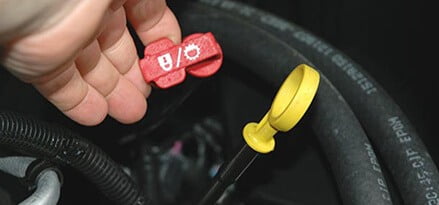What Causes Car Transmission Problems: Unveiling the Hidden Culprits
Low transmission fluid is the primary cause of car transmission problems. It is usually caused by a leak in the system, resulting in low or contaminated fluid that hinders smooth gear shifting. Car transmission problems can be frustrating and costly to repair. Understanding the causes of these issues can help car owners identify and address them promptly. One main cause is low transmission fluid, which can occur due to leaks in the transmission system. Contaminated or insufficient fluid makes it difficult for the transmission to shift gears smoothly. Another common cause is wear and tear on the transmission parts, such as worn clutches or bearings, leading to slipping gears or a high-revving engine. Other factors like clogged filters and problems with the clutch can also contribute to transmission damage. It is crucial to address these issues promptly to avoid further damage and costly repairs. Low Transmission Fluid: The Primary Culprit Low transmission fluid is often the primary culprit behind car transmission problems. When the fluid is low or contaminated due to leaks, the transmission struggles to shift gears smoothly, causing issues like slipping, banging, and jerking. Proper maintenance and keeping the fluid clean are crucial in preventing these problems. Effects Of Low Transmission Fluid On Gear Shifting When it comes to car transmission problems, low transmission fluid is often the primary culprit. Insufficient or contaminated fluid can wreak havoc on your transmission’s ability to shift gears smoothly. The effects of low transmission fluid on gear shifting can be quite significant. Firstly, low transmission fluid can cause delayed or rough gear shifts. You might experience a noticeable delay when transitioning between gears, resulting in a jerking or jolting sensation. Additionally, you may notice that your vehicle struggles to accelerate properly or fails to maintain a consistent speed. Moreover, low transmission fluid can lead to gear slippage. This occurs when the transmission fails to hold the chosen gear, causing the engine to rev higher than normal without a corresponding increase in speed. Gear slippage is not only frustrating but also puts unnecessary strain on your engine and transmission. Furthermore, low transmission fluid can result in overheating. Without enough fluid to lubricate and cool the various components within the transmission, excessive heat can build up, leading to damage and potential failure. Overheating can cause severe transmission issues and should be addressed promptly. Causes Of Low Transmission Fluid There are several potential causes for low transmission fluid in your vehicle. One common reason is a leak in the transmission system. Over time, seals and gaskets can degrade, resulting in fluid leakage. It’s crucial to regularly inspect your vehicle for signs of leaks, such as puddles or stains underneath the car. Another cause of low transmission fluid is improper maintenance. If you neglect to check and change your transmission fluid at regular intervals, it can become contaminated or depleted, leading to operating issues. Neglecting fluid maintenance also increases the likelihood of other transmission problems down the line. Additionally, water intrusion can contaminate the transmission fluid, causing it to become ineffective. This can happen if your vehicle is exposed to flood or water damage, or if you drive through deep water. Therefore, it’s essential to avoid situations where water can enter the transmission system. Importance Of Regular Fluid Checks And Maintenance Regular fluid checks and maintenance are crucial for ensuring the proper functioning of your transmission and avoiding costly repairs. By adhering to a maintenance schedule and regularly checking the transmission fluid level and quality, you can detect any issues early on and take necessary action. It is recommended to consult your vehicle’s owner manual for the recommended intervals for checking and changing transmission fluid. Typically, a transmission fluid change is recommended every 30,000 to 60,000 miles, but this can vary depending on the vehicle make and model. In addition to fluid checks and changes, ensuring that your transmission filter is clean and in good condition is equally important. A dirty or clogged filter can restrict the flow of fluid and lead to gear slipping and other transmission problems. Regular maintenance not only helps prevent low transmission fluid but also extends the lifespan of your transmission, improves fuel efficiency, and promotes smoother gear shifts. Make it a priority to establish a maintenance routine and consult a professional mechanic if you notice any signs of transmission problems or suspect low fluid levels. In conclusion, low transmission fluid is a major cause of car transmission problems. Its effects on gear shifting can be severe, resulting in delayed or rough shifts, gear slippage, and overheating. Practicing regular fluid checks and maintenance is essential to prevent low transmission fluid and ensure the longevity of your transmission. Worn-out Clutch: A Common Cause Of Transmission Issues Worn-out clutch is a common cause of transmission issues in cars. When the clutch becomes worn, it can lead to slipping gears, difficulty shifting, and a high revving engine. This can be caused by low transmission fluid, lack of maintenance, or internal wear and tear. Symptoms Of A Worn-out Clutch If your car’s transmission is experiencing issues, one common cause could be a worn-out clutch. Recognizing the symptoms of a worn-out clutch can help you address the problem before it affects your vehicle’s performance and safety. Keep an eye out for the following signs: Difficulty shifting gears Slipping or jerking while changing gears A burning smell coming from the engine compartment Increased engine revving with no increase in vehicle speed A soft or spongy clutch pedal If you notice any of these symptoms, it’s important to address them promptly to prevent further damage to your transmission. Factors Contributing To Clutch Wear And Tear Understanding the factors that contribute to clutch wear and tear can help you take preventative action and extend the lifespan of your vehicle’s transmission. Some common factors include: Frequent stop-and-go driving: Constantly engaging and disengaging the clutch in heavy traffic can wear it out faster. Aggressive driving: Rapid acceleration, hard braking, and shifting gears forcefully increase stress on the clutch. Inexperienced drivers:
What Causes Car Transmission Problems: Unveiling the Hidden Culprits Read More »




